The many benefits of building all-electric include lower construction costs, lower carbon emissions, improved public safety, improved indoor health, higher efficiency, lower utility bills when paired with PV panels, a simplified building process and greater homeowner satisfaction. With all these benefits, designers and builders should move to all-electric homes.
Lower Construction Costs
A study prepared for the Pacific Gas and Electric Company found that the gas-related construction costs for a mixed-fuel home can be up to $30,800 for an average single-family home, ultimately all paid by the buyer. This includes the difference between gas and electric appliances, in-house gas piping and infrastructure, and onsite gas infrastructure.1 Avoided gas infrastructure costs include $140 to $360 per foot for low-pressure distribution lines,2 $16,570 for the meter and lateral,3 and $200 to $1,000 piping cost per fixture.4 These costs are often hidden. The builder or developer may pay less up front or pay nothing at all for infrastructure, but the gas utility recoups these costs through higher usage rates.
Lower Utility Bills
Energy affordability is a critical issue for many American households, with utility bills the number one use of payday loans in the U.S. Those loans are carried an average of 150 days at 400% interest, furthering the cycle of poverty.5 Due to rapid gains in electric appliance efficiency, utility bills for all-electric homes can be up to $800/year less than for comparable mixed-fuel homes.6
The U.S. Department of Energy (DOE) produces “yellow tags” for every appliance on the market, showing the national average annual utility cost. As shown below, an electric heat pump water heater is $70 less per year to operate, which corresponds to a savings of about 40% compared to one of the most efficient gas water heaters. Additionally, some electric utility charges are high enough to make rooftop solar a potential solution to cost-effectively lower utility bills for the entire house.

U.S. Dept of Energy labels show heat pump water heaters cost $70 per year less to operate than the most efficient gas water heaters on the market. Based on U.S. average fuel cost.
When is Electricity Cheaper than Gas?
One misconception commonly heard is that “gas is cheap.” While in many states that is true for the fuel itself, even in the high-electric-cost state of California, replacing gas appliances with electric can save money. Ken Rider, Senior Advisor to the Chair of the California Energy Commission, developed the comparison graphs below to illustrate the utility bill savings of heat pump water heaters compared to equivalent gas water heaters. Studies submitted to the regulatory agencies by SoCalGas and PG&E show the high hidden costs of building with gas, particularly gas plumbing in the building and gas laterals from the street. Additional studies illustrate the significant leaks at each stage.
Savings are small with low-efficiency heat pumps, large with high efficiency heat pumps, and dramatic when solar electric panels are included. Adding solar reduces the cost of operating a water heater by one-half to two-thirds compared to both low and high efficiency gas water heaters.
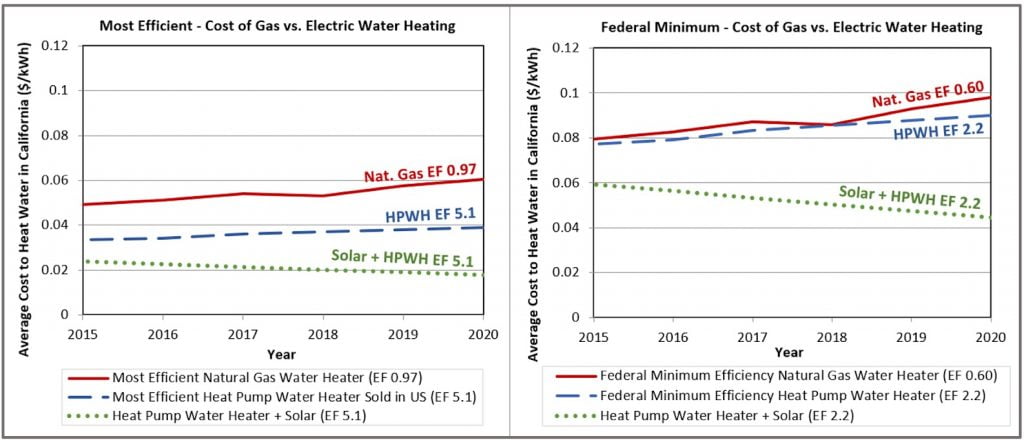
A comparison of the utility bill costs of heating water with gas versus electricity in California, both with the most efficient water heaters and the least efficient.7
Reduced Greenhouse Gas Emissions
Energy used to operate buildings currently contributes roughly 28% of global greenhouse gas (GHG) pollution. Housing construction can rapidly make a large reduction in carbon pollution by avoiding or replacing fossil fuels like gas, fuel oil, and propane with efficient all-electric construction. Additionally, methane leaked from the fracking, storage, and delivery of “natural” gas is an exceptionally strong GHG pollutant, and according to the Environmental Defense Fund, “about 25% of the human-made global warming we’re experiencing is caused by methane emissions.”8 Even when the electricity in the grid comes from coal or gas power plants, households with efficient electric space and water heating appliances produce much less total air pollution than those with the most efficient gas furnaces and water heaters.9 Forty-eight utilities nationwide have made commitments to shift to renewable energy, and many states have mandated renewable energy. New York, Washington, Oregon, and California have committed to having 100% carbon-free power grids by 2045.10
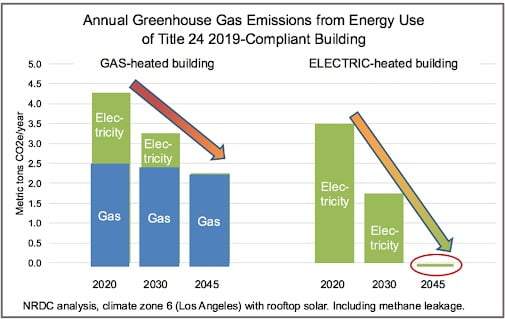
Buildings using gas cannot meet California’s 205 legal commitments, while all electric buildings can. (Delforge, NRDC)
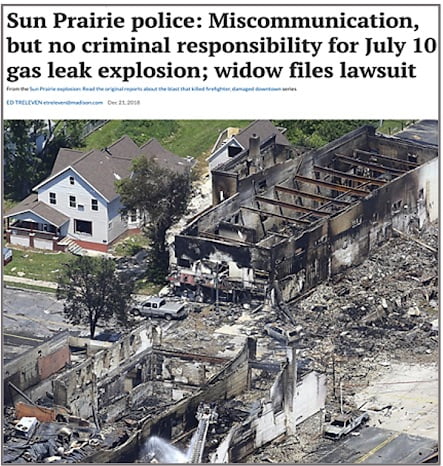
An improperly marked gas line by the utility killed a plumber and destroyed neighboring buildings.16
Improved Public Safety
As the 2019 Camp Fire in California has shown, poorly maintained electric lines can start devastating wildfires under drought conditions, but gas has safety issues of its own. Nationwide, since 2010, the natural gas system has caused 236 public safety incidents and $198 million in damages per year.11 The toll includes causing half of the fires after both the 1994 Los Angeles earthquake and the 1989 San Francisco earthquake.12, 13 Even in the absence of an earthquake, natural gas accidents have killed 548 people and broken more than 9,000 pipelines between 1986 and 2016 in the U.S. (on average nearly one a day).14 In 2010 a major gas main in San Bruno, CA, exploded into flames 1,000 feet high, killing eight people, destroying 38 homes and damaging 70 others, and leaving behind a crater 40 feet deep.15
Improved Indoor Health

Burning gas at home increases childhood asthma. (Photo by Gateway Health)
Dozens of studies17 show gas combustion in homes causes asthma in children. A gas stove doubles the odds a home cook will develop lung and heart disease, and triples the chances that a home cook will need asthma medication.18 Burning gas in household appliances produces damaging levels of pollutants like carbon monoxide, formaldehyde, nitrogen dioxide, acetaldehyde, and ultrafine particles.19 The California Air Resources Board warns that “cooking emissions, especially from gas stoves, have been associated with increased respiratory disease.” The carbon monoxide produced by burning gas in appliances can be lethal;. Carbon monoxide poisoning in the U.S. kills 500 people and sends 15,000 people to the emergency room every year.20
Better for Builders
Beyond construction cost savings, all-electric design benefits builders by:
- Reducing the many hassles of working with a gas utility to provide new services in the street and to the building.
- Reducing construction labor — road closure, trenching, laying pipe, safety inspections, backfilling and road repair.
- Reducing the design costs, construction time and permitting of gas meters, internal gas plumbing, and venting to remove combustion exhaust that is polluted enough that it must vent at least 10 feet distant from an operable window or door.
- Reducing construction hazards. Construction workers can be killed by electrical accidents; but including natural gas in a home adds unnecessary additional risk — most often from hitting gas pipelines with earth moving equipment and construction tools. For instance, in Ohio construction workers hit gas mainlines 410 times in 2015 alone.21
- Eliminating the need for combustion safety testing of gas appliances for leaks, complete fuel combustion, and carbon monoxide back drafting.
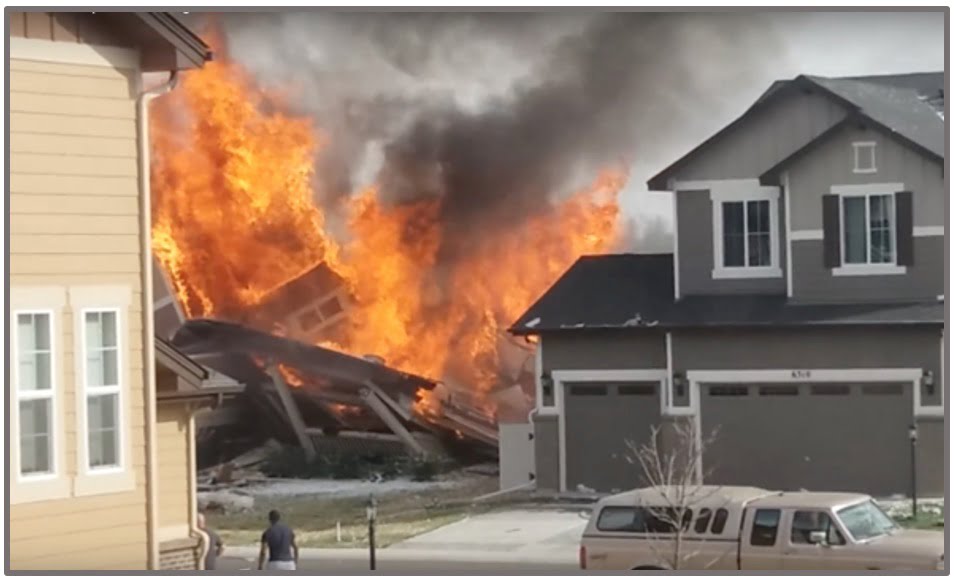
Methane leakage from a Colorado gas well 150’ away caused this explosion that killed two brothers. (Photo by CBS)
Builders will find many benefits from going all-electric: lower construction costs, lower carbon emissions, improved public safety, improved indoor health, higher efficiency and lower utility bills for buyers, and a safer and simplified building process. When paired with energy efficiency measures and rooftop solar collectors. all-electric is the simplest and cheapest way for builders to get to net zero and the best way for builders to satisfy customers and reduce carbon emissions from their buildings.
Sean Armstrong is managing principal at Redwood Energy. This piece is adapted from: A Zero Emissions All-Electric Single-Family Construction Guide | Redwood Energy 2020
References:
- Bruceri, M. (2019). ”Draft 2019 Energy Efficiency Cost-effectiveness Study: Low Rise Residential.” For PG&E Codes & Standards, prepared by Frontier Energy. March 15, 2019.
- California Public Utilities Commission. (2016). An Order Instituting Rulemaking to Identify Disadvantages Communities in the San Joaquin Valley and Analyze Economically Feasible Options to Increase Access to Affordable Energy in Those Disadvantaged Communities. Rulemaking No. 15-03-010.
- Pacific Gas and Electric Company. (2016). Pacific Gas and Electric Company’s (U39G) Cost Estimates for Identified Communities. California Public Utilities Commission. Rulemaking No. 15- 03-010.
- Stone Energy Associates. (2017). Re: 2019 Building Energy Efficiency Standards Development. Docket #16-BSTD-06.
- Levy, R. and Sledge, J. (2012) A Complex Portrait: An Examination of Small-Dollar Credit Consumers. Center for Financial Services Innovation.
- Synapse Energy. (2018). Economics, Decarbonization of Heating Energy Use in California Buildings at 2, 39.
- Rider, Ken. (2020). Email correspondence, ken.rider@energy.ca.gov. March 2020.
- Environmental Defense Fund. (2020). Methane, The Other Important Greenhouse Gas. *EDF calculation based on IPCC AR5 WGI Chapter 8.” Note that other sources like livestock (e.g., cows) contribute to methane emissions also.
- Department of Energy. (2015). “A Common Definition of Zero Energy Buildings.” Table 1, ‘National Average Source Energy Conversion Factors’ shows 3.15 for Imported Electricity and 1.09 for Natural Gas.
- Smart Electric Power Alliance. Interactive State Decarbonization Tracker.
- San Francisco Department of the Environment. (2017). Methane Math: How Cities Can Rethink Emissions from Natural Gas.
- California Seismic Safety Commission. (2002). “Improving Natural Gas Safety in Earthquakes.” SSC-02-03.
- Taylor, A. (2014). “The Northridge Earthquake: 20 Years Ago Today.” The Atlantic.
- Joseph, G. (2016). “30 Years of Oil and Gas Pipeline Accidents, Mapped.” Citylab.
- National Transportation Safety Board. (2011). Accident Report – San Bruno Pipeline Rupture. American Gas Association.
- Treleven, E. (2018). Sun Prairie police: Miscommunication, but no criminal responsibility for July 10 gas leak explosion; widow files lawsuit. Wisconsin State Journal.
- Belanger, Kathleen and Triche, Elizabeth PhDs. (2008) “Indoor Combustion and Asthma.” Immunology Allergy Clinic of North America.
- Jarvis et al. (1996) “Evaluation of asthma prescription measures and health system performance based on emergency department utilization.”
- Singer, B. (2018). Healthy Efficient Homes: Research Findings. ACEEE 2018 Conference on Health, Environment and Energy.
- U.S. Environmental Protection Agency. (2009). Preventing Carbon Monoxide Poisoning.
- Jarosz, Brooks. “Construction worker called in gas line rupture before explosion.” Dec 22, 2016. ABC 6 News, Columbus, Ohio.
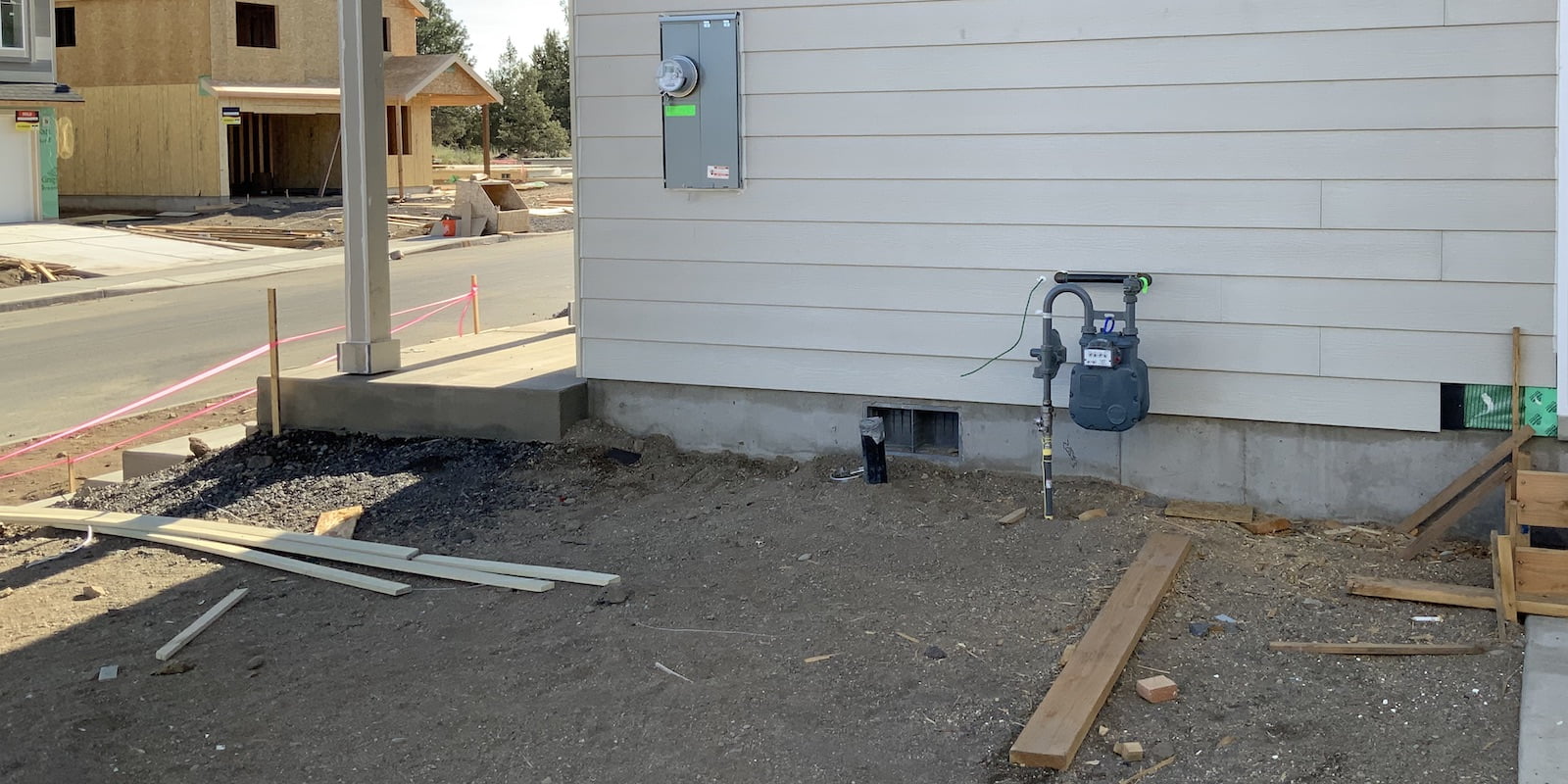

Bruce Sullivan says:
More numbers on the cost of gas infrastructure and gas leakage in California.
https://zeroenergyproject.com/wp-content/uploads/2020/07/Tap-to-Tap-Methane-costs-and-leakage.pdf